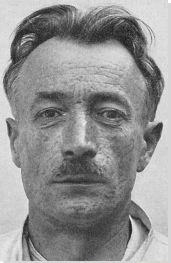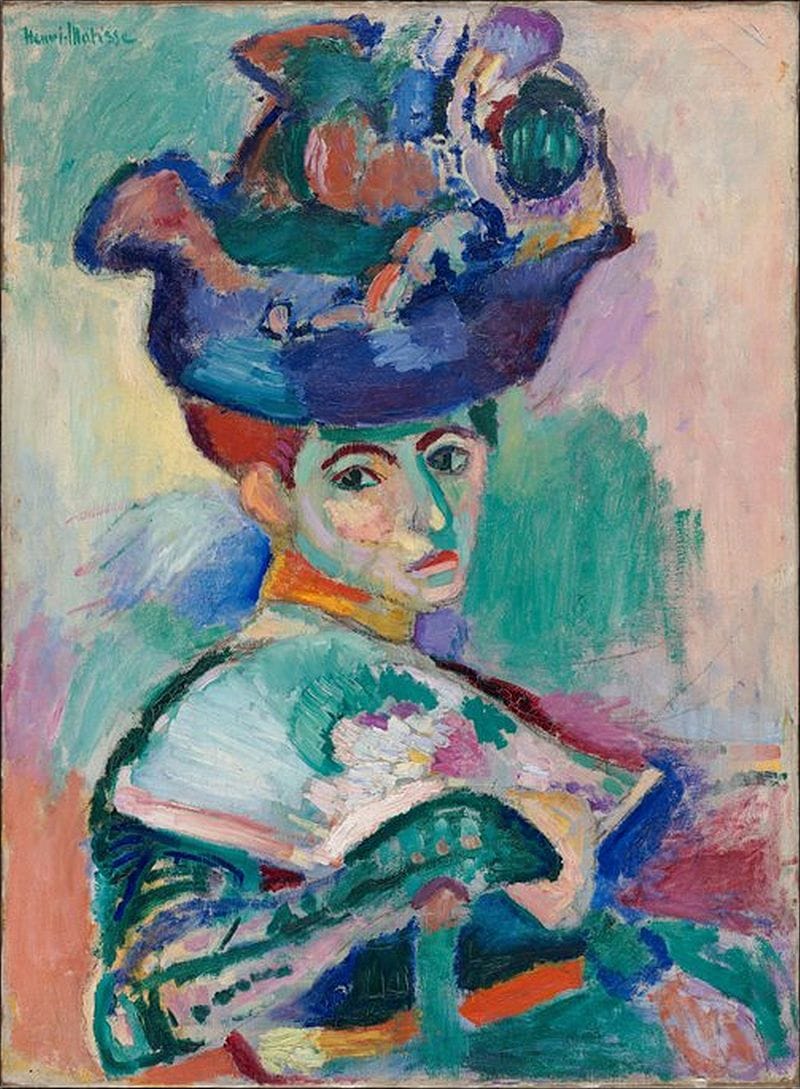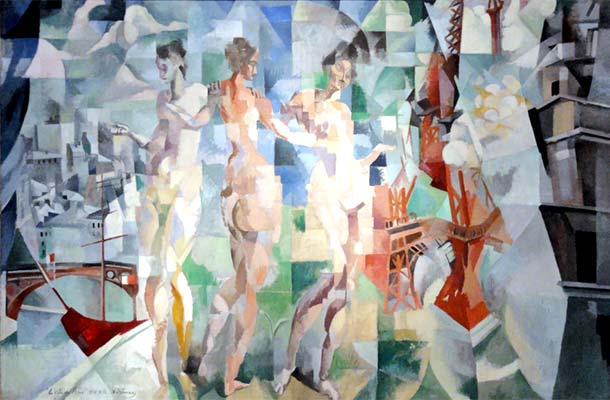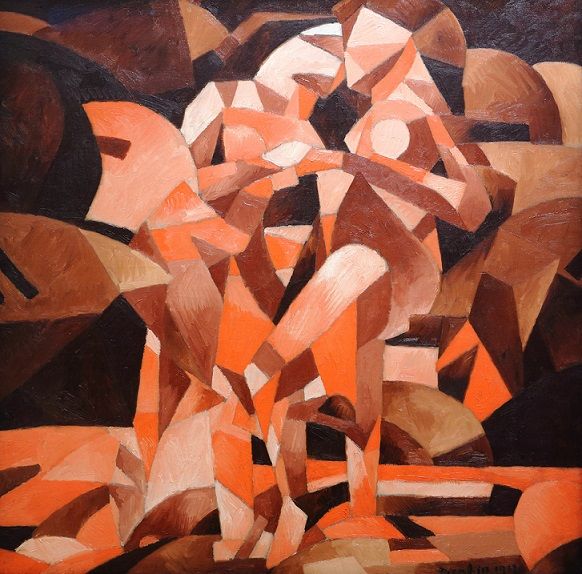Summary of František Kupka
Kupka was a pioneer of abstract art and one of the first completely non-representational artists. Along with artists such as Mondrian and Kandinsky, his mature work formed the foundations for the development of modern art in the 20th century. Although many of his early pieces were figurative or contained realistic elements, he gradually evolved a purely abstract style, seeking to communicate ideas and beliefs without using recognizable imagery but instead conveying them through the use of line, form, and color alone. Whilst he was reluctant to be associated with any particular movement, Kupka worked closely with the Cubists and was instrumental in the development of Orphism, he also drew inspiration from the work of a wide range of other artists including those associated with Futurism and Fauvism.
Accomplishments
- Self-educated, Kupka read extensively and was notably influenced by ideas relating to spiritualism, Buddhism and Theosophy. He incorporated religious symbolism into some of his early work and, later, used the philosophies associated with these religions to create his own belief system focused on revealing the unseen meaning hidden beneath the purely visual, a tenet that informed his move towards abstraction. He also investigated concepts relating to creation and the wider universe in his art.
- In many pieces of his work, Kupka considered the essential nature of color and he was interested in how colors interacted with each other. He drew on both scientific research and spiritual beliefs to study the emotional and psychological effects they could have on the viewer, believing that properly composed color had the ability to allow people to enter a transcendental state.
- The relationship between music and painting became increasingly important to Kupka throughout his career. He drew parallels between the processes of creating music and art, naming a number of his paintings after compositional techniques, particularly 'fugue'. He also utilized music to directly inspire his work, visualizing the rhythms and tones that he heard.
Important Art by František Kupka
The Beginning of Life
This etching, executed a few years after his arrival in Paris, shows the influence of Symbolism on Kupka. Dominating the scene is a floating fetus enclosed in a circle. It is attached through an umbilical cord to a radiating womb which blooms from a lotus flower. In the picture Kupka draws heavily on religious imagery, especially that of Buddhism and Theosophy (a belief system which combined religion, science and philosophy) to represent overarching ideas of birth, life, and renewal. Kupka utilized ideas from numerous sources in his art and had a long-standing interest in mystical and spiritual concepts.
The lotus flower is an important symbol of creation, femininity, and sexual union and is depicted here as the origin of life itself. This was not the first time that Kupka had imbued the Lotus with these qualities and similar imagery can be seen in his earlier painting The Soul of the Lotus (1898). The circles reference the widespread and historical practice of utilizing halos to denote religious figures. Here, they are employed to delineate sacred space, highlighting both the womb and the fetus as holy. In both Buddhism and Theosophy the circle also represents the eternal, symbolizing the infinite universe and the life within it. The interconnected elements in the process of creation stand out against the more muted tones and repetitive shapes of the background and there is a sense of movement and light upwards from the lotus flower to the fetus via the sun-like womb. This emphasizes the importance of birth and growth and the role played by women within this.
Colored etching on paper - Centre Pompidou, Musée National d'Art Moderne, Paris.
Planes by Colors, Large Nude
This is a nude of Kupka's wife and muse, Eugenie, reclining on a sofa. Although the subject matter is quite academic, the artist uses unrealistic colors to model the flesh and face, dividing the figure into several tonal planes. Kupka believed in the existence of an unseen dimension of meaning hidden beneath the purely visual and he attempted to capture this in his art, revealing the model's 'inner form' through his use of color. This aim was supported by the invention of radiography around 1895 which confirmed Kupka's ideas relating to the existence of an invisible reality and encouraged him to view subjects with a painterly X-Ray vision.
The background and sofa are made of horizontal and vertical stripes of colors denying any sense of depth to the picture and this indicates the influence of Cubism on the artist. The painting also demonstrates a debt to the vibrant colors and techniques of Fauvism, particularly the work of Henri Matisse. The painting is more than an imitation of other styles, however, it is a work of experimentation and shows Kupka refining his own language of color and representation. A series of studies for the final painting display a decreasingly figurative approach to the subject and an investigation into different color palettes and arrangements.
The final piece presents a dichotomy between naturalistic detail such as the carefully proportioned figure and the shaft of sunlight highlighting the model's left leg and the less realistic elements including the color and background perspective. This lingering duality in the work is demonstrated by its title which combines the vocabulary of modernism with that of more traditional art.
Oil on canvas - The Solomon R. Guggenheim Museum, New York, New York
Woman picking flower
During the same years Kupka was working on Planes by Colors, Large Nude he also completed a number of pastel studies experimenting with the representation of movement. Here he shows the consecutive phases of motion of a women rising from a chair and leaning forward to pick a flower as a series of silhouettes. Discussing this work a few years after its completion, Kupka wrote, "In order to give the impression of movement through the use of static agents . . . one must evoke a sequence of presences; to do so in the visual arts, one must indicate different intensities of impressions, from the least to the most easily perceptible." Kupka indicates these 'different intensities' through the use of color and thickness of application of the medium. The colors follow a chromatic progression from cool to warm as the sequence evolves and the blurring between the individual outlines suggests the path from one to the next. The blue silhouette contains the most concentrated depth of color, this acts as a central pivot around which the composition rotates designating the mid-point of the sequence of movement.
In creating this painting it is probable that Kupka was inspired by both the invention of chronophotography and the aims of the Futurists. Chronophotography was developed by Etienne-Jules Marey and Eadweard Muybridge and allowed successive phases of motion to be captured in multiple photographs which were often layered into a single image. The Futurists were also interested in the representation of movement particularly from a point of view of speed and machinery and this was highlighted in their 1909 Manifesto. Later, members of the Futurist Movement produced similarly experimental images that attempted to capture the essence of movement including Giacomo Balla's Dynamism of a Dog on a Leash (1912).
Pastel, watercolor and graphite on paper - Centre Pompidou, Musée National d'Art Moderne, Paris.
Disks of Newton
The title of this painting is a reference to the theory of color developed by Isaac Newton in the mid-17th century. The physicist was the first to discover that light from the sun was composed of the seven colors of the spectrum: red, orange, yellow, green, blue, indigo, and violet. Here Kupka represents the sun, shown in the top right of the image as an intense red circle, breaking down into its constituent parts of light. Moving away from this focal point, the colors become cooler in tone and eventually disintegrate into black, the absence of color. Kupka was interested in cosmology and astronomy and it is possible that the two spheres in the foreground represent planets, the concentric circles indicating their paths of orbit and their own rotation.
This work is also known by the title Study for Fugue in Two Colors - the reference to a fugue (a musical compositional technique) adds a further element of meaning to the piece. As with many as his fellow artists, Kupka believed that painting and music were closely allied and that sound could be embodied by color and form, stating that "I can find something between sight and hearing and I can produce a fugue in colors as Bach has done in music." This image in one of a number of studies with the same name, but there is no final version known.
Oil on canvas - Centre Pompidou, Musée National d'Art Moderne, Paris
Around a point
Kupka started to produce studies for this work as early as 1911, finally producing this large oil in the years 1925-30, although he may have reworked elements of it as late as 1934. The piece can be seen as a synthesis of Kupka's ideas, interests, and beliefs about creation, cosmic symbolism, the hidden 'inner', and scientific theories of motion, light, and color. The point was an important concept for Kupka and in his book Creation in the Plastic Arts, he wrote, "The suns and the satellites, ovoid spheres, rings, nebulae and comets that populate infinite space, as astronomy describes it, all of this, to our eyes, simply represents a mass of bright points. On the other hand, other small points, observed with a microscope and that science tells us are part of an infinite multitude of molecules and atoms, even smaller points, become, to the naked eye, bodies, articulated organisms". To Kupka, the 'point' represented a double notion of infinitely big and infinitely small and such themes can be seen in this work.
The focus of the piece is a small black dot, highlighted by a beam of white light. This seems to represent the center of creation and the series of disjointed and interweaving rings which spiral out from it, the expanses of the universe, full of stars, planets and mystic forces. The colors used are subtler than many of his previous works and are dominated by blues and oranges, opposites on a color wheel, and this creates a sense of harmony within the composition. The white background gives it a light and airy appearance and this is furthered by the use of dots to fill planes instead of bands of pure color. This gives a sense of the dematerialization of solid forms, the hidden being revealed beneath the purely visual. It has been suggested that Kupka originally based the shapes of the piece around the image of a lotus flower, simplifying it into curves and spheres and this make sense within the context of the wider symbolism.
Oil on canvas - Centre Pompidou, Musée National d'Art Moderne, Paris
Abstractions
This is one of a series of 16 Abstractions painted by Kupka in the late 1920s and early 1930s. The first 12 were initially published in 1933 on a single page in the second issue of the Abstraction-Creation Review and all 16 were later published in 1948 in a dedicated volume. The Abstractions consist of minimalistic compositions of lines, circles, spirals and rectangles drawn in black on a pure white background. The shapes are thoughtfully arranged within the space on the canvas and each image differs significantly from the others. They are reflective of a wider move from sinuous shapes to streamlined and geometric forms as embodied by the increasing popularity of Art Deco.
In creating these, the artist aimed to purify his forms, producing radically simplified, austere images that focused on the importance of shape and line above everything else. The geometric forms in this example are all arranged vertically and of this Kupka noted in Creation in the Plastic Arts that "In the vertical there is all the majesty of the static. It contains at once the top and the bottom, combining them ... In its solemnity, the vertical is the backbone of life in space, the axis of all construction; it monumentalizes the most trivial sketch that has been squared"
Through the canvases of Abstractions Kupka sought a truth outside of pictorial representation. By breaking painting down into its constituent parts the artist does not allow the viewer to relate the shapes to their visual understanding of the world, instead they must interpret the inner meaning of them, revealing a hidden reality which will differ for each viewer as they bring their own experiences to bear on the painting. As early as 1912, Kupka wrote "The straight line represents the abstract world. It is absolute", these images represent a culmination of this belief.
Gouache - Musée National d'Art Moderne, Paris
Biography of František Kupka
Childhood
František Kupka, also known as Frank Kupka or François Kupka, was born in Eastern Bohemia in 1871, the oldest of five children of the notary Vaclav Kupka and his wife Josefa. For financial reasons, he left school and started work at the age of 13 for a saddle maker. This lack of formal schooling remained a source of humiliation for Kupka throughout his life and inspired him to engage in extensive self-education. Although he disliked his job, his first employer introduced him to spiritualism and he incorporated ideas relating to this into his early work. After a couple of years Kupka left this role and travelled around Bohemia earning money through sign painting. During this time he cemented his interests in philosophy, history and painting. Upon his return he enrolled in Jaromer Technical College where his work came to the attention of the Swedish artist Alois Studnička who started his formal artistic education and instructed him in drawing and the decorative arts.
Early Training
Strunicka prepared Kupka for entry to the Academy of Arts in Prague in 1889. Here the young artist took classes in sacred and historic painting under the tutelage of František Sequens. In 1892 he moved to Vienna and enrolled in the Vienna Academy of Fine Arts concentrating on allegorical and symbolic subjects. He had some success as an artist in the city and was commissioned to paint a handful of portraits for members of the court. He also read heavily, devouring everything from anatomy to philosophy and chemistry to witchcraft and his interest in Eastern philosophy, Theosophy and occult practices dates from this period. He combined these various spiritual sources to develop his own belief system which focused on the existence of an invisible reality hidden beneath surface appearances.
In 1896, the artist left Vienna and visited London and Scandinavia before settling in Paris. He briefly attended the Academie Julian and continued his studies with Jean-Pierre Laurens at the École des Beaux-Arts. Like his countryman Alfons Mucha, Kupka earnt his living by working as an illustrator, cartoonist and designer, creating posters for cabarets such as the famous Le Chat Noir. Coming from a modest background and having struggled to make ends meet throughout his artistic training, he was sensitive to the social and political events in France and grew close to Parisian anarchist circles. Along with artists such Theophile Steinlen, Jean-Louis Forain and Felix Vallotton, his cartoons were commissioned by satirical, socialist and anarchist reviews including l'Assiette au Beurre and Les Temps nouveaux. In 1904, he illustrated the final volume of La Nouvelle Géographie universelle, la terre et les hommes written by Elisee Reclus, a renowned geographer and important figure in the anarchist movement and this helped to establish his reputation. He also began to experiment with different styles of painting incorporating elements of the Fauvist, Symbolist and Post-Impressionist work that he saw in the capital.
Mature Period
In 1906, Kupka married Eugenie Straub, known as Nini and moved to Puteaux, a village on the outskirts of the capital where rent was lower. Here he continued to work as a cartoonist but also began to focus on his painting again and around 1910 his style became increasingly abstract, capturing ideas of color and motion, in part inspired by the first Futurist Manifesto published in 1909.
In Puteaux, his neighbor was Jacques Villon who, along with his brothers Marcel Duchamp and Raymond Duchamp-Villon, and other artists such as Albert Gleizes and Jean Metzinger, formed the Section d'Or (also called the Puteaux Group), a collection of artists associated with what is also referred to as Salon Cubism. Kupka attended many of the group's gatherings and met artists, writers, scientists, and mathematicians who had an impact on his work. Through this association Kupka, along with Robert Delaunay and Sonia Delaunay, developed a type of Cubism focused on bright colors and the purely abstract. In 1912 the poet and art critic, Guillaume Apollinaire named this type of work Orphism, specifically referencing three of Kupka's works as examples of the style. Writing a year later, Apollinaire described Orphism as "the art of painting new totalities with elements that the artist does not take from visual reality, but creates entirely by himself...An Orphic painter's works should convey an untroubled aesthetic pleasure, but at the same time a meaningful structure and sublime significance". Orphism did not survive beyond World War One, but is now viewed as a key transitionary style between Cubism and abstract art.
In 1912, Kupka presented his painting Amorpha, Fugue in Two Colors at the Salon d'Automne, this monumental composition was one of the first abstract paintings shown in Paris and was very different from popular art of the period, the public, on the whole, reacted negatively to it. In the same year, he exhibited alongside his friends at the Salon of the Section d'Or and in 1913, he was included in the Cubist room at the Salon des Independants. Kupka, however, did not wish to be associated with any particular artistic movement, commenting to a friend that "in the last Salon d'Automne I had a beautiful place of honor, unfortunately in the room with the Cubists with whom I am almost on a parallel. It is with me as it was with Degas, who was classified as an Impressionist."
In 1914, with the outbreak of the First World War, Kupka enrolled in the Foreign Legion with other overseas artists and writers including Swiss poet Blaise Cendras. His wife attempted to accompany the unit on their march to Picardy but after the first day she was arrested by the officer in charge and returned to Paris, she later travelled to the Front to see him. The artist returned to Puteaux with frostbite in his foot from standing in freezing water in the trenches and started to work again on paintings he had left behind. After the war, many artists returned to figurative painting, Kupka was no exception and he reintegrated human figures into some of his work. He also became interested in machines and mechanization and incorporated these into his paintings. In 1921, he had his first solo show in Paris at the Russian gallery, Galerie Povolozky. During these years, the Prague Academy appointed the artist as a Professor and it was Kupka's responsibility to introduce Czech scholarship students to French culture and art.
Although Kupka completed his book, Creation in the Plastic Arts in 1913 he struggled to find a publisher for it in Paris. It was eventually published in 1923 in Prague. The text summarized his ideas on abstraction and his own development towards it as well as examining scientific and metaphysic theories. In particular, Kupka discussed the impact of color on human emotion believing that different colors provoked different sensations in a viewer. He summarized this stating that "a point, a line, an outline, any indicator of location in space is a deliberate statement which reflects what is taking place in the mind (or the 'soul') of the artist. But color and shade are positive in themselves, imposing themselves as elements able to make an impression even before they have been given any intentional form".
Late Period
Late In 1931 Kupka returned to pure abstraction and he was a founding member of Abstraction-Création, a group that was dedicated to the recognition and dissemination of abstract art and saw itself as a counterbalance to the highly popular Surrealism movement. The group attracted major abstract artists of the period including Kandinsky, Mondrian, and Naum Gabo and had a total membership of around four hundred. They also formed links with modernist groups in other countries such as the Seven and Five Society and Unit One in the UK. The group was active until 1936, holding regular exhibitions across Europe and publishing five yearbooks (1932-36) entitled Abstraction-création: Art non-figuratif. It was as part of this group that Kupka focused more intensely on abstract work inspired by music including Jazz-Hot No. 1 (1935) and Music (1936). In these years, poor health forced Kukpa to spend a lot of time on the French Riviera. In 1936, he was included in the major retrospective at the Museum of Modern Art in New York, Cubism and Abstract Art and alongside Mucha at the Galerie du Jeu de Paume.
During the 1940s Kupka started to be officially and internationally recognized. The Czech government as well as the Museum of Modern Art in New York purchased several of his pieces and in 1946 the Galerie S.V.U. Mánes in Prague held a retrospective of his work. In the 1950s he held several solo shows in New York and he continued to work until his death in 1957 at the age of 86. He died in Puteaux in the same house where he had lived since 1906.
The Legacy of František Kupka
Kupka worked successfully in a variety of styles and forms throughout his career. He was a popular and successful illustrator and cartoonist, but he is most remembered as an innovative figure in the move towards abstraction and one of the first completely non-representational artists. Due to his reluctance to be associated with any individual movement, however, his significant contribution to abstract painting is not as recognized as that of Kandinsky, Malevitch, or Mondrian. Furthermore, Kupka operated in unpredictable ways, re-working older canvases, giving multiple pieces the same name and even destroying or making replicas of his own work and this approach has hampered historians trying to reclaim his role in the creation of modern abstraction. Through his role with the Prague Academy, Kupka's teachings also left their mark on a generation of Czech artists who were inspired by his abstract work including František Foltýn who attended lectures by Kupka in Paris during the mid-1920s.
Influences and Connections

-
![Henri Matisse]() Henri Matisse
Henri Matisse -
![Jacques Villon]() Jacques Villon
Jacques Villon -
![Robert Delaunay]() Robert Delaunay
Robert Delaunay - Frantisek Sequens
-
![Jacques Villon]() Jacques Villon
Jacques Villon -
![Marcel Duchamp]() Marcel Duchamp
Marcel Duchamp -
![Francis Picabia]() Francis Picabia
Francis Picabia - Jindrich Waldes
-
![Francis Picabia]() Francis Picabia
Francis Picabia ![Max Bill]() Max Bill
Max Bill
-
![Robert Delaunay]() Robert Delaunay
Robert Delaunay -
![Sonia Delaunay]() Sonia Delaunay
Sonia Delaunay ![Blaise Cendrars]() Blaise Cendrars
Blaise Cendrars
-
![Orphism]() Orphism
Orphism -
![Concrete Art]() Concrete Art
Concrete Art - Abstraction
Useful Resources on František Kupka
- František Kupka: Catalogue RaisonnéOur PickBy Agnes Husslein-Arco, Vladimir Lekes, Ludmila Lekes, Eliska Zlatohlavkova
- KukpaBy Serge Fauchereau
- František Kupka, 1871-1957: A Retrospective, The Solomon R. Guggenheim Museum, New YorkBy František Kupka, Meda Mladek, Margit Rowell

























